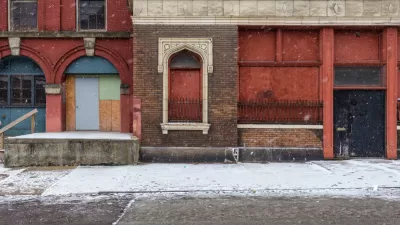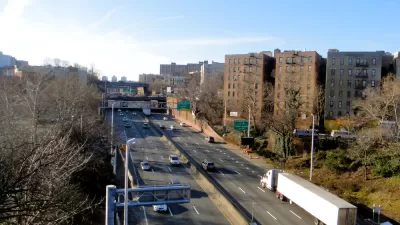The long-sought after demolition of Bronx's Sheridan Expressway hits obstacles as the City of New York now looks to save and retrofit it.
Tearing down urban freeways and expressways is a strategy that has been growing in popularity around the world. Most famously implemented in San Francisco after the demolition of the Embarcadero Freeway, the project's success gave other cities the impetus to tear down antiquated and little-used stretches of highway.
As Sarah Goodyear of The Atlantic Cities writes, the Bronx's Sheridan Expressway "...was number two on the Congress for the New Urbanism's list of "Freeways Without Futures," and it made the Urban Land Institute's short list of potential teardown projects as well..."
But, the City of New York recently reversed the decision to demolish the road, citing "concerns about truck traffic headed for the nearby Hunts Point Produce Market, the city's main wholesale outlet for fruits and vegetables, as well as other potential traffic problems." The city, instead, is looking to retrofit the aging highway.
Residents are fighting back, stating that preserving the Expressway is only going to be used as an incentive for a grocery delivery service to the Bronx over concerns of the citizens, inciting a fight between the needs of industry and those of the citizens.
Article author Sarah Goodyear also points out that "[o]nce a freeway is in place, it takes on a life of its own, an aura of inevitability...antiquated roads like this one still have brute staying power."
FULL STORY: Freeway Removal Hits a Roadblock in the Bronx

Manufactured Crisis: Losing the Nation’s Largest Source of Unsubsidized Affordable Housing
Manufactured housing communities have long been an affordable housing option for millions of people living in the U.S., but that affordability is disappearing rapidly. How did we get here?

Americans May Be Stuck — But Why?
Americans are moving a lot less than they once did, and that is a problem. While Yoni Applebaum, in his highly-publicized article Stuck, gets the reasons badly wrong, it's still important to ask: why are we moving so much less than before?

Research Shows More Roads = More Driving
A national study shows, once again, that increasing road supply induces additional vehicle travel, particularly over the long run.

Judge Halts Enforcement of Anti-Homeless Laws in Grants Pass
The Oregon city will be barred from enforcing two ordinances that prosecute unhoused residents until it increases capacity and accessibility at designated camping sites.

Advancing Sustainability in Los Angeles County Schools
The Los Angeles County Office of Education’s Green Schools Symposium brings together educators, students, and experts to advance sustainability in schools through innovative design, climate resilience strategies, and collaborative learning.

Using Old Oil and Gas Wells for Green Energy Storage
Penn State researchers have found that repurposing abandoned oil and gas wells for geothermal-assisted compressed-air energy storage can boost efficiency, reduce environmental risks, and support clean energy and job transitions.
Urban Design for Planners 1: Software Tools
This six-course series explores essential urban design concepts using open source software and equips planners with the tools they need to participate fully in the urban design process.
Planning for Universal Design
Learn the tools for implementing Universal Design in planning regulations.
City of Moreno Valley
Institute for Housing and Urban Development Studies (IHS)
City of Grandview
Harvard GSD Executive Education
NYU Wagner Graduate School of Public Service
City of Cambridge, Maryland
Newport County Development Council: Connect Greater Newport





























